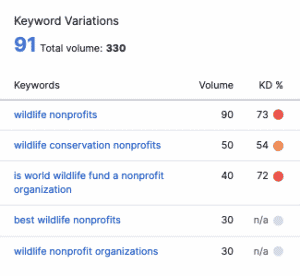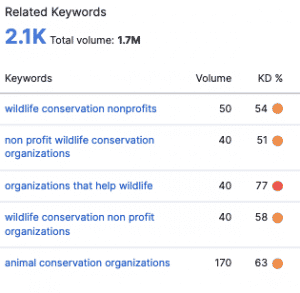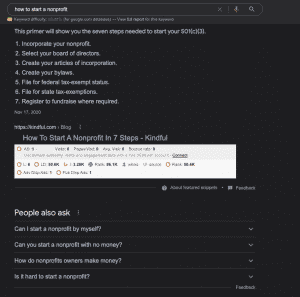
What is Search Intent and Why is it Important for Nonprofits?
Search intent comes down to one thing: understanding the why. It’s important to understand why users are searching for your content or nonprofit. Knowing your ideal audience’s intent will set you apart from the competition. Now let’s dive in!
What is Search Intent?
In this post, we will walk through the concept and strategy of understanding search intent, better known as the ‘why’ behind a query on search engines. Knowing user intent for your nonprofit ensures that your site and content can be targeted to the right audience.
If you know what your audience is searching for, you can use search engine optimization to increase your mission’s organic visibility!
Why Is Search Intent Important for Nonprofits?
It’s no secret that your nonprofit can benefit from more donations, volunteers, and people who are passionate about your mission. To get there, it’s important to make sure we know what those users are searching for.
For example, if your nonprofit focuses on saving endangered wildlife, users might be searching for “wildlife nonprofits.” They might also search for a phrase like “how to help save endangered animals” and knowing this, you can create blog posts or donation pages to answer their question! Many nonprofits and companies assume they know what their audience is searching for, and they create web content around those assumptions. Skipping the step of understanding search intent can be a fatal flaw in a marketing strategy.
 .
. 
*data pulled from Semrush
Once your nonprofit understands your audience and their search intent, it’s simple to do keyword research, create content, and optimize that content for search engines.
Why Search Intent Matters
It’s actually considered a ranking factor! Informational searches come from users trying to fill a knowledge gap. The purpose of a search engine is to show users the best, most authoritative, and trustworthy content in response to their query. The closer you can align your blogs and topic pages to the search intent, the more likely you’ll rank in SERPs or snag a featured snippet placement (and higher click-through rates) for that keyword.
You will see both long-tail and short-tail keywords when looking on search engine results pages (SERPs) or when researching search terms. A short-tail keyword might be “local nonprofit.” It’s short, to the point, and usually has a higher search volume, making it more competitive to rank for. A related long-tail keyword might be “a local nonprofit that helps feed the homeless.”Longer tail keywords are often more specific, lower volume, and less competitive, meaning you might rank for them more easily than the main focus or short? keywords.
Let’s walk through the different kinds of search intent.
The Four Kinds of Search Intent
- Informational: users want to know something. They want to learn new information on a given topic or have a question answered (e.g., “wildlife nonprofits”)

*data pulled from Semrush when searching for ‘wildlife nonprofits”. You can see that these related keywords are either informational, commercial, or a combination.
- Navigational: users are trying to go somewhere on the internet. They are looking for a specific website or landing page (e.g., “Twitter login”)
- Commercial: users are weighing the value of their potential purchase or are shopping for a product (e.g., “What is the best online education program?”)
- Transactional: users who are ready to make a purchase now or take action (e.g., “donate to wildlife organization”) and are looking to search engines to make that happen
How to Determine Search Intent
Many SEO platforms, such as Semrush or SpyFu, will indicate the intent within their keyword research tools, which makes it even easier for us! When doing keyword research, filter out branded keywords, as we are trying to target queries that don’t have your nonprofit’s name listed.
If you want to start with targeting informational keywords, you can also filter to find only keywords containing a question – those are primarily informational intent.
Without a tool, you can also look at the SERPs, as the results should indicate the intent. What is the top ranking link, and what purpose does that page fulfill? Does it describe something? Send you to a specific site? Compare two products? Provide a donation form?
It’s clear from SERPs that search terms like “how to start a nonprofit” have an informational intent. The results page for this term includes featured snippets which brings in organic links.

Creating an SEO Strategy Around Search Intent
Understanding user and search intent is the first step in creating a strategic and purposeful SEO strategy. This step is extremely important, as your whole strategy will revolve around your audience and the journey they take to find you and your content.
Search intent matters. Your nonprofit can rank higher in SERPs by closely matching what a reader is looking for when they search. Relevancy and value will boost your rankings in the SERPs, bringing more qualified traffic and conversion to your site. Understanding intent and keyword modifiers can help align your blogs and content with exactly what your desired user is searching for. Learn more about our SEO services for nonprofits today!